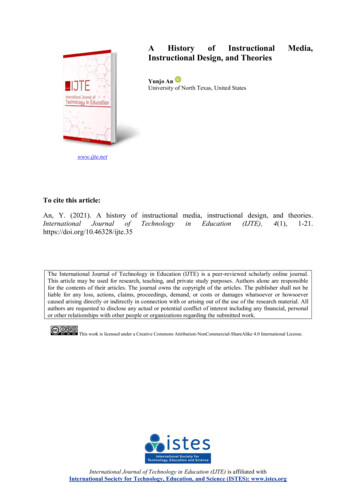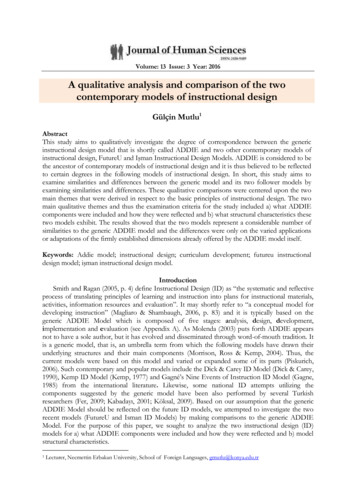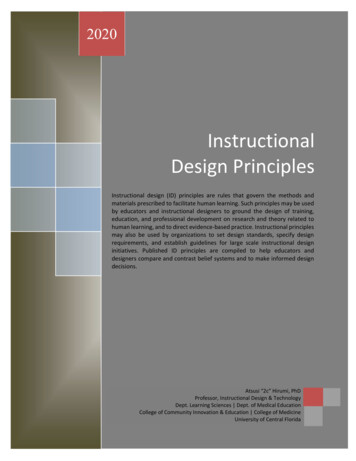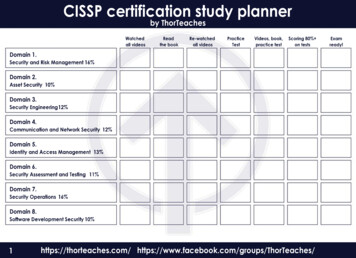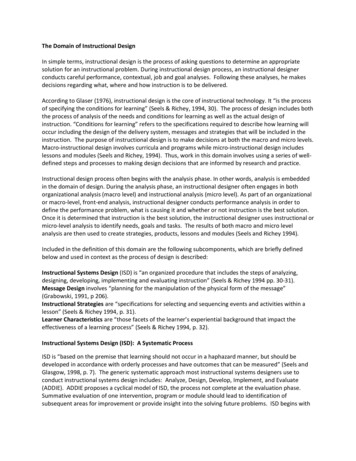
Transcription
The Domain of Instructional DesignIn simple terms, instructional design is the process of asking questions to determine an appropriatesolution for an instructional problem. During instructional design process, an instructional designerconducts careful performance, contextual, job and goal analyses. Following these analyses, he makesdecisions regarding what, where and how instruction is to be delivered.According to Glaser (1976), instructional design is the core of instructional technology. It “is the processof specifying the conditions for learning” (Seels & Richey, 1994, 30). The process of design includes boththe process of analysis of the needs and conditions for learning as well as the actual design ofinstruction. “Conditions for learning” refers to the specifications required to describe how learning willoccur including the design of the delivery system, messages and strategies that will be included in theinstruction. The purpose of instructional design is to make decisions at both the macro and micro levels.Macro-instructional design involves curricula and programs while micro-instructional design includeslessons and modules (Seels and Richey, 1994). Thus, work in this domain involves using a series of welldefined steps and processes to making design decisions that are informed by research and practice.Instructional design process often begins with the analysis phase. In other words, analysis is embeddedin the domain of design. During the analysis phase, an instructional designer often engages in bothorganizational analysis (macro level) and instructional analysis (micro level). As part of an organizationalor macro-level, front-end analysis, instructional designer conducts performance analysis in order todefine the performance problem, what is causing it and whether or not instruction is the best solution.Once it is determined that instruction is the best solution, the instructional designer uses instructional ormicro-level analysis to identify needs, goals and tasks. The results of both macro and micro levelanalysis are then used to create strategies, products, lessons and modules (Seels and Richey 1994).Included in the definition of this domain are the following subcomponents, which are briefly definedbelow and used in context as the process of design is described:Instructional Systems Design (ISD) is “an organized procedure that includes the steps of analyzing,designing, developing, implementing and evaluating instruction” (Seels & Richey 1994 pp. 30-31).Message Design involves “planning for the manipulation of the physical form of the message”(Grabowski, 1991, p 206).Instructional Strategies are “specifications for selecting and sequencing events and activities within alesson” (Seels & Richey 1994, p. 31).Learner Characteristics are “those facets of the learner’s experiential background that impact theeffectiveness of a learning process” (Seels & Richey 1994, p. 32).Instructional Systems Design (ISD): A Systematic ProcessISD is “based on the premise that learning should not occur in a haphazard manner, but should bedeveloped in accordance with orderly processes and have outcomes that can be measured” (Seels andGlasgow, 1998, p. 7). The generic systematic approach most instructional systems designers use toconduct instructional systems design includes: Analyze, Design, Develop, Implement, and Evaluate(ADDIE). ADDIE proposes a cyclical model of ISD, the process not complete at the evaluation phase.Summative evaluation of one intervention, program or module should lead to identification ofsubsequent areas for improvement or provide insight into the solving future problems. ISD begins with
the analysis phase. The premise is that without solid analysis and appropriate design, instructionalproducts are without foundation and, in most cases, ineffective.In addition to ADDIE as a generic approach, instructional designers choose from a number ofcomprehensive and detailed ISD models. Among others, Dick, Carey & Carey (2005) and Seels andGlasgow (1998) models are the widely used ISD models. Both models follow the ADDIE process,although there are some differences between them. For example, while Dick, Carey & Carey (2005) offera much more detailed prescription for front-end analysis, Seels and Glasgow (1998) take a broaderapproach in describing their model, leaving the designer with a number of procedural decisions basedon the project. In addition, Dick, Carey & Carey (2005) do not address the implementation stage of theADDIE process, whereas Seels and Glasgow (1998) attempt to touch on all phases in their model,offering processes for project management and implementation (Seels and Glasgow, 1998, Dick, Carey &Carey, 2005). However, despite these differences, both models offer instructional technologists acomprehensive approach to identifying and analyzing a problem, designing an appropriate solution,developing instructional materials, and designing formative and summative evaluations. Instructionalsystems design models are also known as procedural models. Procedural models are problem solvingor systematic guidelines for solving instructional problems. These models assist instructional designersin conducting systematic or step-by-step approach to designing instruction.To describe instructional design processes, instructional designers may formulate guiding questions toassist them in the processes of analysis and design. The following sections summarize these guidingquestions and how instructional designers use these questions to analyze a performance problem andidentify and design a learning solution.“What is the problem? How did we get here?”Determining and understanding the problem so completely that it can be solved is a challenging task(Rossett, 1987). In many cases, the problem and its causes are obvious; other times, often in complexsystems, the problem is hidden, rooted beneath the layers of policy, procedure or social systems.Unearthing it requires careful analysis work prior to initiating the design of instruction (Dick, Carey, &Carey, 2005).When encountering a complex performance problem at the organizational level, front-end analysis is,perhaps, the most important step in the ISD process. As Seels and Glasgow (1998) assert, instructionmay not always be the best solution. Thus, it is essential to analyze the problem, to identify the need orproblem and to ensure that instruction is the best solution. Once it is determined that instruction is thebest solution, the approach to take when attempting to design instructional interventions is to firstidentify the needs or the gaps between “what is” and “what should be.” Needs will then be convertedto goals or learning outcomes which in turn will later be used to conduct goal or task analysis, todetermine what skills, knowledge, and attitudes are required to perform the tasks successfully (Seels &Glasgow 1998). The outcome of performance analysis is a clear description of the problem, a list ofpossible causes and solutions, and, in case of an instructional solution, a list of needs and goals.What must be learned? What are the goals and objectives?As a list of needs and goals has been developed, the instructional technologist must take those goals andbegin the process of identifying what should be taught using the processes of task, learner, context andinstructional analysis (Dick, Carey & Carey 2005). These processes will help the instructional designer to
formulate learning goals in order to determine what the learners will be able to do upon completion ofthe instructional program or module. In analyzing identified learning goals, the technologist should becareful to identify the primary domain under which it falls.Domains of learning, as researched by both Robert Gagne (1962, 1965) and Benjamin Bloom (1956) areways to classify the information to be learned. Bloom (1956) identified the cognitive, affective andpsychomotor domains of learning, while Gagne (1985) identified verbal information, intellectual skills,cognitive strategies, attitudes and motor skills. Within each domain of learning, educators havedeveloped taxonomies to assist the designer in determining “(a) the type of learning, (b) the sequenceof instruction and (c) the scope of planning for instruction by grouping similar types of capabilities”(Seels & Glasgow, 1998, pp. 60-64). Through a careful goal and task analysis, performance objectives arewritten to identify specific skills to be performed in order to achieve learning goals. Performanceobjectives are derived from goals, which are too broad to provide evidence of learning (Seels & Glasgow1998).Performance objectives should address every unit of instruction and should be measurable. According toMager (1975), performance objectives should: (1) describe the identified skill or behavior as an actionusing precise verbs, (2) describe the prevailing conditions when a learner carries out a task to help targetspecific learners, materials and abilities, and (3) describe the criteria that will be used to evaluatelearner performance. As the performance objectives have been established, the technologist then turnshis attention to determining what strategies will be used to determine whether learners are achievingthe desired results.How will we know if the objectives have been met?Designing assessment instruments before designing instruction is critical in determining instructionalstrategies. By designing assessments before instruction, the technologist is able to: (1) align one-to-onewith performance objectives and (2) design the instructional strategy based on the nature of theassessment items (Dick, Carey & Carey 2005). In the K-12 public schools arena, this concept (termed“Backward Mapping” or “Backward Planning”) has become “the most innovative strategy in curriculumdesign” (Luongo-Orlando 2003). This is very interesting since Dick and Carey’s model of instructionaldesign was originally developed in 1978 and included designing assessments before instructionalstrategies.Assessment strategies can be used before, during and after an instructional program or module (Seels &Glasgow 1998). Assessment for learning (formative) assessment is used to guide instruction andlearning, allowing course instructors and learners to know whether performance objectives are beingattained or whether revision is needed. Assessment of learning (summative) is used to determineoverall achievement of course goals and objectives and whether learning occurred. Assessmenttechniques tend to be distributed across a spectrum from objective (multiple choice, matching) toperformance (portfolio, case study, etc.). The types of assessments used will help determine theinstructional strategies used to ensure learners meet performance objectives.What instructional strategies will be used? How will messages be designed to facilitate learning?What is the best delivery system?Instructional strategies are “an overall plan of activities to achieve an instructional goal” (Dick, Carey, &Carey 2005). The term instructional strategy is used to cover a variety of decisions including:
Selection of a delivery systemClustering of contentDescribing learning components of instructionGrouping of studentsLesson structureSelection and design of instructional media (Dick, Carey & Carey 2005)Each of the above components contributes to the overall design of a learning program or module. Atthis point, an instructional technologist should choose an instructional design theory that will describe indetail how learning will occur. Richard Mayer’s SOI Model (1992), David Jonassen’s ConstructivistLearning Environment (1999) and Hanafin, Land and Oliver’s Open Learning Environment (1999)(Reigeluth, 1983) offer specific strategies for actual message and delivery design.Message design is planning for how information will be delivered to the learners – how the“instructional message” will be communicated. Messages can be in the form of still or moving images,static or dynamic text, audio or video. When designing messages, the technologist must be sure tospecify both the medium and the learning task at both the macro and micro-levels of instruction (Seelsand Richey, 1994). Richard Mayer, a leading researcher in message design, specifies the way in whichmessages should be designed in his SOI Model with the learner (1) selecting relevant information, (2)organizing the information into some usable format and, (3) integrating the new information into anadvanced organizer (Reigeluth, 1983). As messages are designed, the technologist must keep in mindthe design of a delivery system, media, or specific way that information is carried to the learner (Seels &Glasgow, 1998).Delivery system options include print, audiovisual, computer-based or integrated technologies (Seelsand Glasgow, 1998, p. 329). A detailed discussion of these delivery systems is located in the domain ofdevelopment. Seels and Glasgow (1998) suggest that while channel requirements (instructional goals,objectives and assessment requirements), learning situation (contextual analysis) andconstraints/resources (contextual analysis) are important to delivery system selection, learnercharacteristics play a much more critical role. An instructional technologist should first consider thepsychological, physical or sociological facets of a learner’s background before making a decisionregarding delivery system (Dick, Carey & Carey 2005, Seels and Glasgow 1998).What learner characteristics will affect the overall design of instruction?Seels and Glasgow (1998) suggest that “psychological characteristics prerequisite skills, ability,motivation and learning style] will affect the difficulty and appeal of the material to the learner . . .physical characteristics [need for mobility] can influence the decision about which media will be mosteffective] . . . sociological characteristics [socio-economic background] may have a bearing on entrylevel skills” (p. 122). While the above statement focuses on the selection of the delivery method, Dick,Carey and Carey (2005) see learner characteristics as critical to the entire process of design.Dick, Carey and Carey (2005) assert that information regarding entry behaviors and prior knowledgeboth affect objective formulation. They also suggest that learner characteristics such as attitude towardcontent and potential delivery system, academic motivation, ability levels, general learning preferences,attitudes toward training organization, and group interaction all greatly influence objective design and avariety of other design strategy components.
Dick, Carey and Carey (2005) suggest John Keller’s ARCS Model for Psychological Motivation (1987) as away of informing and motivating learners of the impending instruction, as well as ensuring theirprerequisite skills. The model is intended to be included within the design of instruction, not as aseparate model (Keller, 1987). Aspects of the ARCS model include: (A) gaining the attention of thelearners through sensory stimuli, inquiry arousal and variability; (R) establishing relevance by answeringthe critical question, “What’s in it for me?”; (C) raising confidence that objectives are achievable; and(S) increasing the level of satisfaction through some type of reward system (Keller, 1987). Newermodels of motivation suggest that a new “breed” of student has emerged, the “Net generation”(Oblinger and Oblinger, 2005).Oblinger and Oblinger (2005) suggest that in order to better educate the “Net generation,” instructionaldesigners must not assume that old models will continue to work. They also assert that the style ofinstructional delivery must also change. They assert that the new learners must be engaged in realworld problems, using relevant tools and resources for learning. Instructor control must relax anddesigners must begin to realize the value of learning by doing, focusing on the ethical and resourcefulapplication of knowledge rather than simply imparting knowledge to students (Oblinger and Oblinger,2005). Research in learner motivation suggests that the analysis of learner characteristics is in fact oneof the most important characteristics that influence the design of instruction.Researchers seem to agree that if an instructional technologist has not taken certain characteristics ofthe potential learners into account at all levels of the design process, sound instructional decisionmaking is at stake and the process of instructional design is flawed (Seels & Glasgow 1998, Dick, Carey &Carey 2005). The implication is that if the analysis and design are flawed, the product created by the ISDprocess will also be substandard.
The Domain of Instructional Design In simple terms, instructional design is the process of asking questions to determine an appropriate solution for an instructional problem. During instructional design process, an instructional designer conducts careful performance, contextual, job and goal analyses. Following these analyses, he makes


